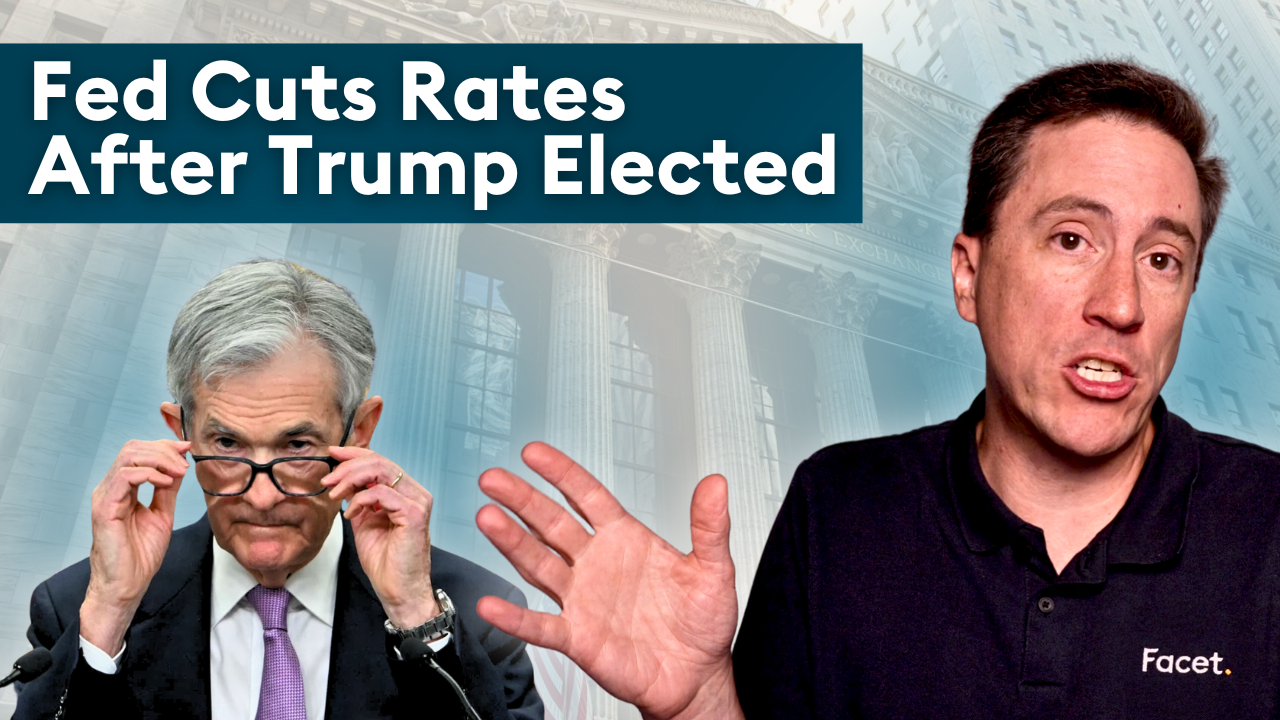
Key takeaways
- The Federal Reserve made no changes to its interest rate target following its December 13th meeting, with the focus shifting from how high it will hike to how soon before it will start cutting
- The Fed uses the concept of a ‘neutral rate’ when making decisions, which is the rate by which policy is neither tight nor loose, and it was indicated that current policy is “restrictive”
- The Taylor Rule states that the Fed's target rate should be equal to 2% plus expected future inflation, which suggests potential for a cut in rates if inflation subsides
- Powell opened up the possibility of a reduction in rates at their next meeting and lowered their 2024 inflation and rate forecast
- CPI has been declining substantially over recent months and could hint at 1% worth of rate cuts if trends continue
As was widely expected, the Federal Reserve made no changes to its interest rate target following its December 13th meeting. In fact, the market’s focus has completely shifted from how high the Fed will hike to how long before the Fed starts cutting.
Fed Chair Jerome Powell did not give any overt signals about when cuts might be coming, but he did give us some important clues on the criteria for making such a decision. Here’s what we think this all means for you.
Why consider cutting rates?
Before getting into what the Fed actually said at the meeting, let’s consider a more fundamental question: why are we even talking about rate cuts at all?
While inflation data continues to improve, it is still well above the Fed’s target. And besides, you probably think of rate cuts as something that only happens when the economy is tanking, not when unemployment is 3.7% (add link). And yet, Fed officials have begun to openly speculate on when it might be time to cut.
The first thing to consider is the idea of a neutral interest rate. While no one knows precisely what the neutral rate is, it is a concept the Fed uses heavily in its decision-making. It is the rate by which policy is neither tight nor loose, neither boosting the economy nor holding it back.
When the Fed needs to fight inflation, it must get policy above this neutral rate. The greater the gap between the neutral and the actual rate, the more restrictive policy is. The more restrictive the policy is, the faster inflation will decline and the greater the risk of causing a recession.
Again, we can’t tell what the neutral rate is at any given moment, but one can surmise that if inflation is declining, the policy rate must be higher than neutral. Powell said in several past press conferences that current policy was “restrictive.” For the Fed, this term means a policy rate that is solidly above neutral.
Logically, the degree to which policy needs to be restrictive when inflation is 6% isn’t the same as when it is 3%. The Fed still wants to set the target above neutral to ensure inflation keeps declining, but it doesn’t want to restrict the economy more than necessary and cause a recession.
The Fed uses a tool called the Taylor Rule to help analyze this situation. Originally developed by Stanford economist John Taylor in the 1990s, there are now many variations on the original rule.
Even within the Fed, different economists prefer different formulations. However, it is probably one of the most heavily referenced concepts in all of macroeconomics. So, its underlying concepts are extremely influential in central bank policy-making worldwide.
The rule is fairly simple. One version the Fed uses says the Fed’s target rate should be equal to:
2% + Expected Future Inflation + (0.5 * Inflation-Target Inflation) + (0.5 * Full Employment-Unemployment)
You notice in the formula that as inflation declines, so will the whole sum of the formula, even if inflation is still above target.
The chart below shows the Taylor Rule output as defined above vs. the actual Fed target. Here, we’ve used the 3-month rolling Core PCE as our inflation measure, the 5-year TIPS break-even as our inflation expectations estimate, and 4% as the full employment figure.
 Source: Federal Reserve
Source: Federal Reserve
We can see that the Fed doesn’t follow this Taylor Rule perfectly. It was slow to hike in 2021, presumably because it thought inflation was brought on by “transitory” COVID-related factors. It then hiked rapidly toward the Taylor estimate in 2022 and 2023. But now, with inflation subsiding, the current Fed target is above the Taylor estimate.
Again, this specific estimate of the Taylor Rule is not the be-all and end-all. As we said above, there are several variations on this measure and different assumptions that would come to somewhat different conclusions. But the concept that the Fed should cut rates as inflation subsides, even if it is still above target, is very well-rooted in macroeconomic theory.
While Powell didn’t focus on the Taylor Rule in his press conference, Fed Governor Christopher Waller did mention it in a recent speech where he seemed to suggest the Fed could start cutting rates in the first half of 2024. So we know this idea is on the Fed’s mind.
Powell opens the door for rate cuts next year
During the post-meeting press conference, Powell was asked a few questions about the potential for rate cuts. This time, he had a noticeable change in tone. In November, he flatly said that “the Committee is not thinking about rate cuts right now at all.” This time, he said that now that the Fed is probably done hiking, the “natural next question” for the Committee is when it will be time to “dial back” restrictive policy. While emphasizing that no decision was made, he did say that this was “a discussion for us at our meeting today” and that the time for rate cuts “begins to come into view.”
There is a reason why Powell is broaching this subject now. The Fed has a tricky communications job regarding rate cuts. It is very likely Fed winds up lowering rates before inflation is all the way to 2%, that may be confusing to the public. It will want to start messaging why cuts might make sense so that both markets and the public understand their motivations. While the timing of cuts may be a ways off, it makes sense for Powell to start messaging the rationale behind cuts now.
Fed lowers its 2024 both inflation and rate forecast
The Fed also released its quarterly Summary of Economic Projections (link) or SEP. This is essentially a survey of all Fed Committee members about their own economic forecast, including inflation, unemployment, and economic growth. Members also put down where they would set the Fed’s target rate if their own economic forecast came to fruition.
Notably, the median 2024 inflation forecast declined from September, the last time the Fed released the SEP, going from 2.6% to 2.4% now. In addition, the median Committee member now thinks a somewhat lower Fed rate target will be appropriate by the end of 2023. That figure had included two rate cuts in 2024 when the Committee was surveyed in September. Now the median is for three cuts, or 0.75% total, next year.
Note that these rate cuts should not be considered a forecast per se. Remember, each member is putting down what rate target they think would be appropriate contingent on their own economic forecast coming to fruition. In other words, the Committee is saying that if inflation were to be at 2.4% at the end of 2024, it would probably be sensible to have cut rates by 0.75% as well.
This reinforces the point we made above: the Fed is perfectly willing to cut rates as inflation declines, even if it remains above their target.
Inflation data may be improving even faster than the Fed assumes
What is notable about the Fed’s 2.3% inflation forecast for 2024 is that we might already be there a year early. The Fed uses Core PCE as their formal inflation target. Over the last three months, Core PCE has run at a 2.37% pace. So basically even without any improvement, merely keeping up the recent pace for inflation, the Fed’s 2024 forecast will be realized. If that’s the case, then 1% worth of rate cuts should probably be our base expectation.
 Source: Bureau of Economic Analysis
Source: Bureau of Economic Analysis
The Consumer Price Index (CPI) is another well-known inflation measure. Generally, the CPI runs a little higher than the PCE due to some technicalities of how certain things are measured. But that, too, has been declining substantially lately. It hit its lowest year-over-year figure since 2021 in November and is running at 3.4% on a three-month basis. That’s down from over 5% as recently as May.
We would expect the Fed to wait a few months before seriously considering cutting rates. Powell said during his presser that “a long way to go” before inflation was at their target, and that “no one is declaring victory” despite improving inflation numbers. However, we think it likely that if inflation remains on its current trend, by the time the Fed meets in March or May of next year, Powell will have gained that confidence, and the Fed may be ready to cut.
Markets will continue to focus on rate cut language
Stocks have been rising in recent weeks in no small part because Fed rate cuts appear to be more and more likely. This is partly due to a sense that longer-term interest rates are a bit more certain now, and markets like certainty.
It is also partly because the Fed is now better able to deal with any kind of economic slowdown. When inflation was still very high, the Fed’s hands were tied. Even if a recession came, it couldn’t cut rates until inflation subsided. If inflation is no longer an acute problem, the Fed can respond to the beginning of a downturn with rate cuts and perhaps avoid a deeper slowdown.
While all of that is good, we should emphasize that company earnings growth will be at least as important a driver for stocks in 2024. If the Fed tweaks rates lower because inflation continues to ease and overall economic growth remains strong, that could be a very positive combination for stocks. In that scenario, company profits should be robust, boosting stocks.
But if earnings are weak, it won’t matter how much the Fed cuts. That will weigh on stock prices. While we’ll continue to monitor the Fed, our investment analysis is currently more focused on the potential for earnings growth and resiliency to any kind of slowdown.


